...or at least how I find them. There may be other ways to find shark teeth on the beach, and I'll touch on those briefly, but I'll focus mostly on my methods.
 |
| Although Myrtle Beach isn't a premier collecting location, it sure is fun finding shark teeth there while you're on vacation. This blog post hopefully will help you. |
First of all, let me state that there are more productive fossil hunting locations along the U.S. Eastern Coastal Plain, so this isn't a recommendation to collect there if you plan specifically hope to find the megalodon or great white shark tooth of your dreams, although large nice teeth are possible. However, if you are planning a vacation to Myrtle Beach, then finding shark teeth and other fossils are just another fun activity and well worth the effort. Even though I go to Myrtle Beach to vacation, any time that I'm fossil collecting, I may take it a bit more seriously than others.
Let's start off with the right tools for the job. The most important tool is... (drum roll inserted here) ...ready? Your eyes. That's right, your eyes. You need to discern the shapes and characteristics of shark teeth from the gazillions shell fragments that you may encounter on the beach. After that, additional tools are up to you.
 |
| The most important tool that you'll need are your peepers...learn what the teeth look like and their characteristics and you'll find them. There are other useful tools, but these are the best. |
 |
| OK, well some of us, like me, need a little help... |
Other than my eyes, my other tools and things that I carry with me consist of a tool to assist me in collecting that I refer to as my "pick up tool", some sort of container to keep your finds in, a fanny pack to carry essentials (water, cell phone, room key, camera, etc.), and comfortable footwear.
 |
| My "pick up tool" consists of a frying skimmer that I purchased at Gander Mountain, some Gorilla tape, and PVC pipe cut to an appropriate length. My collecting container is an old mayo container with a large lid. It will easily hold large and small shark teeth. |
My "pick up tool" has one important function to me, to save my back. Bending over a thousand times in a day can really give an old codger like me a week long back ache or worse. This tool allows me to pick something up and bring it up to my eyes where I can see it. If the item is small, I simply pick up it along with the sand surrounding it. The tool allows me to also catch stuff in the surf much more quickly than if I had to launch after it with my hand because I carry the tool at beach level, like an extension of my arm and hand, at all times. Waves may still steal something from my grasp, but my odds of collecting something are increased dramatically while using the "pick up tool".
Also, regarding my collecting tool, or collecting in general here. I pick up just about anything that is different than a shell, or that I think is a fossil or shark tooth. I'd say that about ninety percent of what I pick up is not a shark tooth. Still, I keep checking. Every now and then, I pick up something that I don't think is a shark tooth, and it turns out to be one!
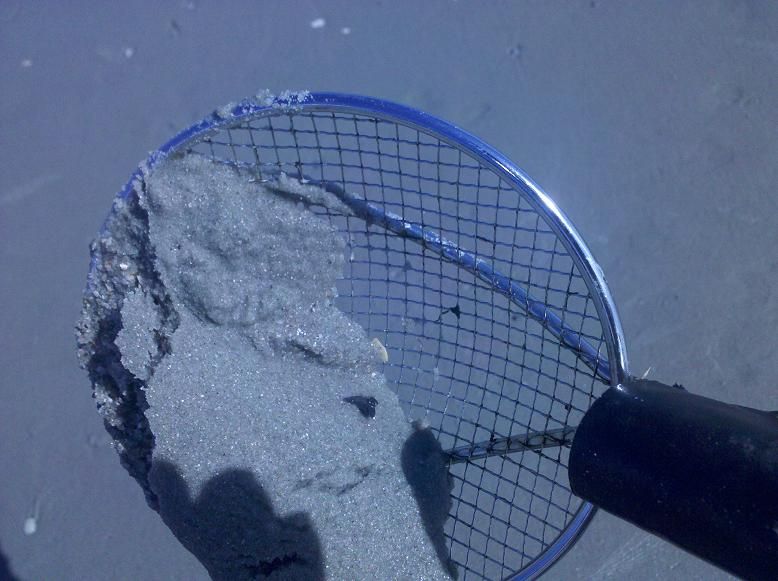 |
| When I see something that I think might be a shark tooth or something else of interest, I use my "pick up tool" to bring it closer to eye level and save my back from a future back ache. If it's a small object, I grab everything around it too. |
Well, you may ask, why not just go barefoot? After all, you're on the beach, right? My response would be, "True, and if you prefer that, go for it." But, I personally find that if the bottoms of my feet are protected from shells and other debris, then I can focus on finding the teeth rather than the bottoms of my dawgs getting sore. So, I either wear flats shoes (designed for fishing the flats) or Crocs. Both types of shoes can be worn easily in the water. The flats shoes keep sand and shells out, and allow me to walk on shells and rocks without cutting the bottoms of my feet, and also prevent blisters caused by sand.
 |
| Flats shoes, like these from Bass Pro Shops, protect the bottoms of my feet from getting cut by shells and other beach material. I may look goofy out there, but I'm comfortable, and when I'm comfortable, I can more easily focus on what I'm searching for. |
Crocs are OK, but I also wear socks to prevent blisters. The only problem with using them is that when collecting in the surf, shells find their way between your feet and the shoes, so you'll constantly be cleaning them out.
 |
| Well, here's a fossil nerd if I ever saw one! I may look goofy, but my feet are comfortable and I have everything that I need to collect as long as my family permits me to do it. |
In the summer, it's hot out there, so make sure that you bring plenty of water along and wear sun screen if your skin is as fair as mine. I can't stress enough about how important having enough water available is while collecting. If you stress from the heat and sun, your concentration goes down, and when that happens, not only does your collecting suffer, but your health most likely will too. It can be dangerous out there if you aren't careful.
A few years ago, I left my resort hotel and walked quite a ways collecting. I had two bottles of water and it had to be well over a hundred degrees out there with no wind at all. I ran out of water half way on my return trip. Fortunately, I ran into my soon to be friend Carl from Northeast Pennsylvania.
Carl walked up to talk to me to ask about what I was up to, like so many people do each year. After explaining what I was doing and showing him my finds, he offered me an ice cold beverage. It was a Yuengling to be exact.
Now I'm not a big beer drinker, although I love the taste of a good beer now and then, drinking water is far better for you health wise to prevent heat stroke, but, let me tell you friends...that Yuengling was like heaven! Ice cold and hit the spot. It cooled me down instantly. And, fortunately, my walk back wasn't all that far. So, not only will you have fun collecting and possibly gain some attention, you'll make friends along the way by nice folks like Carl. I see him every year at the same spot during my vacation and he flags me down to say hi, offering me a Yuengling each time. I'm forever thankful to Carl for that ice cold beverage. Thanks Carl!!!!
As far as techniques go, I see other collectors sifting the shell beds or simply using their hands to sort through the beach material either by fanning the shell bed or digging a hole and allowing the sides to cave in exposing teeth. You may find other tools successful as well, like trowels, rakes, shovels, etc. They may all assist you in finding fossils on the beach as they might at other locations. I prefer a lot less work while I'm on vacation, so surface collecting for me is the ticket.
So next, you may ask, where would I find shark teeth at Myrtle Beach? My answer is, on the beach. I'm not saying that to be smart, but they're there, and they can be anywhere. I think that the odds of you finding shark teeth increase when you find shelly material on the beach as the teeth could be mixed in. But really, any wave can uncover one in the sand or amongst the shells. Or, the wind could expose a fossil well above the tide line, perhaps where someone sunbathed just hours earlier. Or, perhaps someone built a sand castle and the waves are destroying the fortress, exposing teeth and other shells exposed from someone's sand castle building efforts.
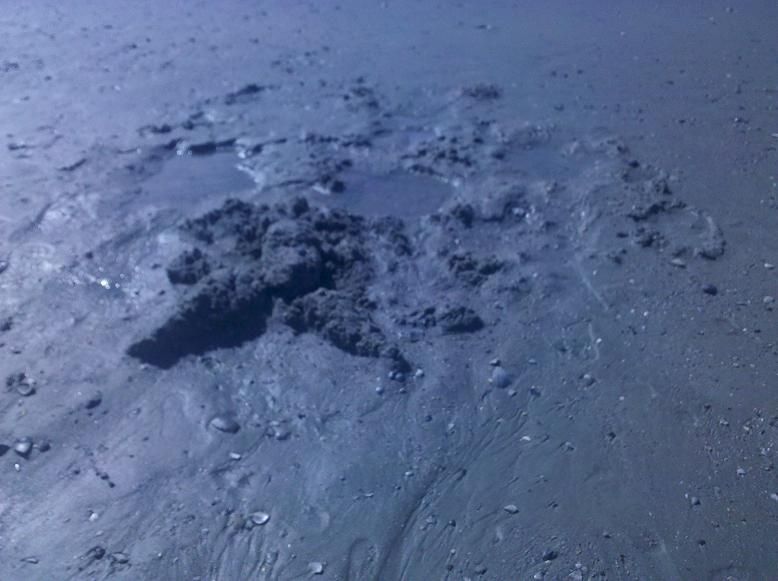 |
| Sand castle ruins may cause tears from the young folks who build them once they are destroyed by the mighty ocean, but fossil collectors may find tears of joy if the exposed fossils result in a good find! |
I guess what I'm saying is that, once you learn to identify teeth, you can find them just about anywhere on the beach. You'll find your favorite spots, probably from where you find the most success. But keep an open mind. Any place that you notice fossil material, whether it's old fossilized shells, porpoise or whale bone fragments, or internal molds of gastropods, you have a chance at finding fossilized shark teeth.
 |
| Creek mouths, like this one, provide a constant source of erosion, moving sand and shells. Sometimes you can see the shark teeth just tumbling down to you. The trick is to catch them and not let them get buried or carried away by a wave (this is where my "pick up tool" comes in handy). Some storm drains don't flow much, but are worth checking after a thunderstorm. |
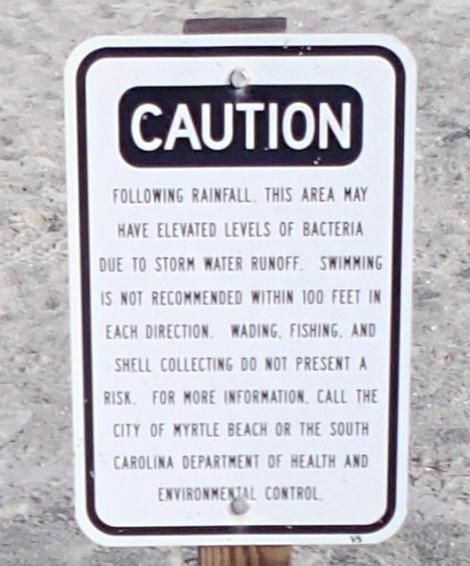 |
| This sign says it all about the creek mouths along the beach. It's OK to collect, but I wouldn't want any of this water in my eyes or mouth. I'd be careful about subjecting exposed sores or open wounds to this water as well. |
 |
| One of the best places to find shark teeth is where the water meets the shoreline and washes shell material back and forth. The waves act like a massive sorting maching, moving material around constantly. Use it to your advantage, the waves can be your friend. My collecting tool helps me keep from losing larger teeth in the surf, and getting them much more quickly than bending over. |
A couple more tips about where to find shark teeth on the beach. First, larger teeth are usually found with larger shell fragments and other beach material. Tidal currents and waves can move large shark teeth, but they travel a bit less than lighter materials. The same is true with shells. So, it's more likely that larger shells and teeth would be found together. Disclaimer: not always though...it's not a golden rule. It's just an observation that seems to be true most of the time. That said, I've found larger teeth all by their lonesome laying right on the sand without even a shell fragment within yards of it.
Massive shell beds aren't easy to search, so take your time. You may find it easier to search where the waves have washed the material down, where shark teeth stand out more against the sand, making them easier to see. Once you become familiar with the shapes and other characteristics of shark teeth, you will be able to see them among the shells.
The shell beds always seem to be sorted with objects of similar size, and lay on the beach in zones. At low tide, you may wish to search all of the zones or simply follow one down the beach. How you approach this is simply up to you. Keep in mind that there is no way that you can cover the entire beach and find every tooth. It's just too massive. So, pick a spot and focus on that area.
At low tide, if the water isn't moving shell material, my approach is to follow a likely zone traveling slowly parallel to the surf until I find a tooth or some sort of indication that fossils are there. Once I find a tooth, I switch gears and move perpendicular to the surf, moving up toward the high tide line while searching with my eyes for teeth across zones. After I reach the high tide line, I move a bit in one direction to my right or left, and travel back down toward the water, slowly moving and sweeping my eyes across the shell material keeping and eye out for teeth. I basically work about a fifty or hundred yard stretch in a grid like manner this way. If you have trouble finding teeth, slow down.
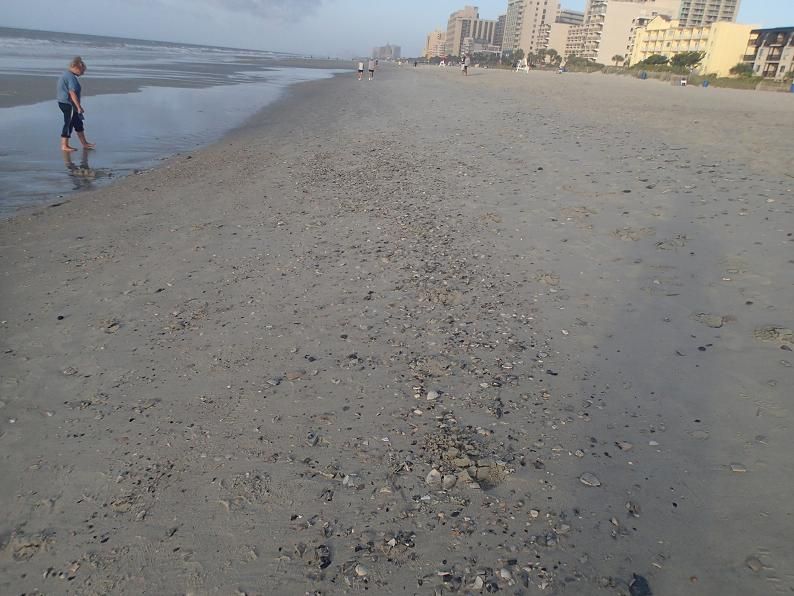 |
| Looking parallel to shore, you can see the various tidal zones, or shell deposits, that you may find shark teeth mixed in with the shells. Some people find a tooth, and search the zone in the same general path that they found the other tooth in. Others move back and forth, mixing their search up. I prefer to search across the zones (right to left, then left to right in this picture) and cover the entire section of beach that interests me. |
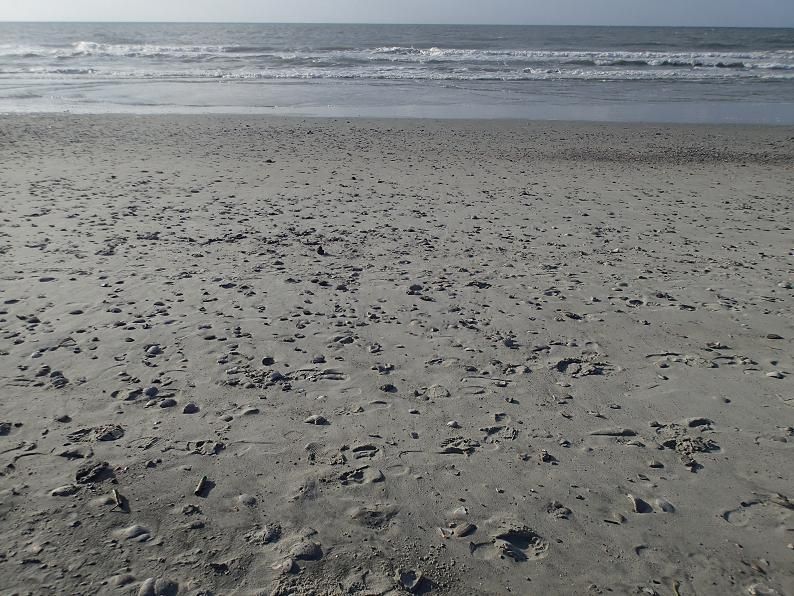 |
| Standing at the high tide area while looking toward the surf, you can easily see the various tidal deposit zones. I prefer to move across these zones, from the surf toward the high tide line, and then in the reverse direction. Move slowly and search back and forth with your eyes for signs of teeth. |
If the surf is washing shell material directly, I move slowly along the waters edge, watching intently as waves move beach material around, waiting for it to uncover my prize. When you see a tooth, or what may be a tooth, grab it quickly before the next wave attempts to sweep it away or bury it with sand.
Now that we've discussed where you might find teeth, let's take a look at some very basic anatomy of a shark tooth and the characteristics of fossilized shark teeth that will help you discern the teeth from the scads of shell fragments on the beach. I'm not going to post all of the different types or shapes in this post, but will do so in a future post. Instead, I'll point out things that will help you find teeth in general. First, all shark teeth that are whole and not broken have a root and a blade with a distinct cutting edge.
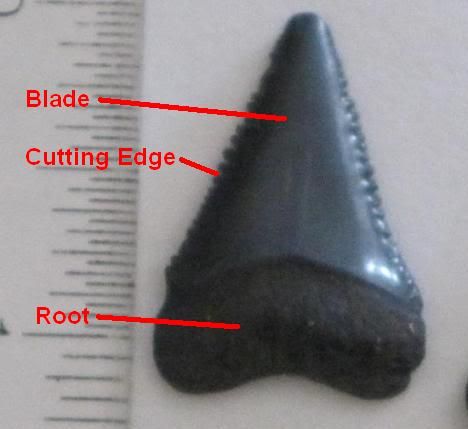 |
| This great white shark tooth that I found a year ago demonstrates what all shark teeth have in common, no matter the shape. Whole teeth all have roots, blades and cutting edges (along the entire length or only partially along the blade). |
The shark teeth that you may find at Myrtle Beach will most likely be fossilized and have some sort of coloration. Modern day teeth are pure white, and you can see them at the bottom of the shark tank at the Ripley's Aquarium. The fossilized teeth colors vary from grays, greens, browns, to almost pitch black. Some may be cream colored. The coloration depends on the minerals that leached into the tooth during the fossilization process, which may have occurred over millions of years. Most of the teeth at Myrtle Beach seem to be black, perhaps due to higher phosphate levels in the fossil layers.
Most of the teeth that you'll find will be broken, perhaps without the root, or only one lobe of the root. Most will be small, about a half inch or less in size. And most will be worn, although you may find a good many teeth that are in good shape. My tip for you is to pick them all up until you learn what a tooth is or what a tooth is not. If you can spot the small or broken teeth, then you'll be able to spot whole or large teeth, either buried or completely exposed.
Once you learn what is a tooth and what is not, you'll spot many more teeth. You'll achieve what my daughter and I refer to as getting "the eye". Just remember, teeth have cutting edges, shells do not. Teeth, even broken ones, are almost perfectly designed as teeth, shells are irregular and imperfectly formed (no offense meant to shell collectors, but from a shark tooth hunting perspective being that teeth are perfectly designed to cut while shells are not).
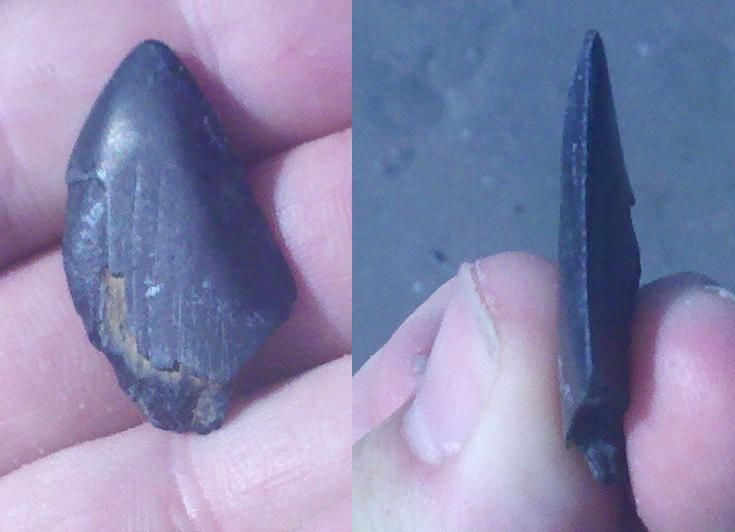 |
| This extremely worn great white tooth still exhibits the traits of a tooth. Notice the distinct cutting edge and regularity of the blade. Even broken teeth exhibit the near perfect "complexion" of a blade. |
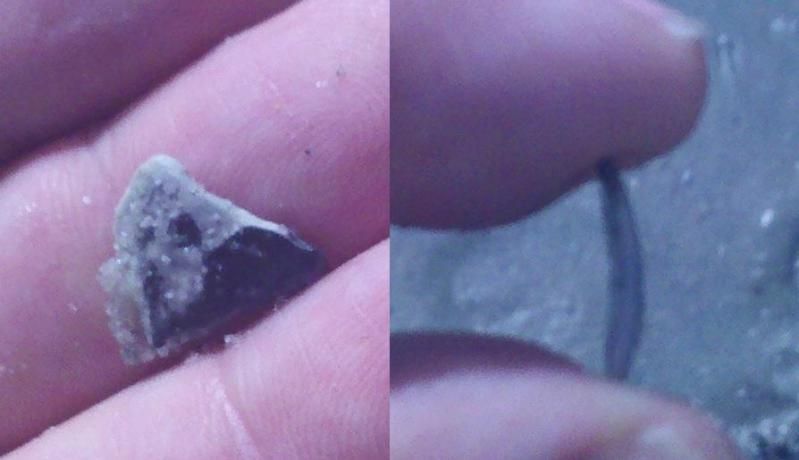 |
| Shells, on the other hand, may be shaped like a tooth overall, but don't have the cutting edge or the regularity of a blade. They, unlike shark teeth, are irregular or imperfect, often showing growth rings, wavy texture, or an irregular surface. This is NOT a tooth. Once you learn what a tooth is and what isn't, you'll have "the eye". |
Here's another tip. Forget about shells when tooth collecting. Focus on finding only teeth, at least until you gain more toothin' experience. If you try to find both simultaneously, you'll find less teeth and perhaps overlook a great find right under your eyes. There's nothing at all wrong about shell collecting, and if you do that just realize that it's tough to do both. At least, for me that's true. I basically ignore shells and search for fossils. So my advice is to do one, or the other.
Also, since the majority of teeth that you'll find will be black, focus on that color at first. Then, once you find a few shark teeth and begin to get the hang of it, pay more attention to the shapes and other characteristics than just the color. Shark teeth also tend to shine a bit more than shells, perhaps because the enamel on the teeth is so smooth, the reflective properties are a bit better than shells. Teeth that are wet tend to be a bit easier to see also.
Here are some pics before and after the find, to give you an idea of what you may be looking at.
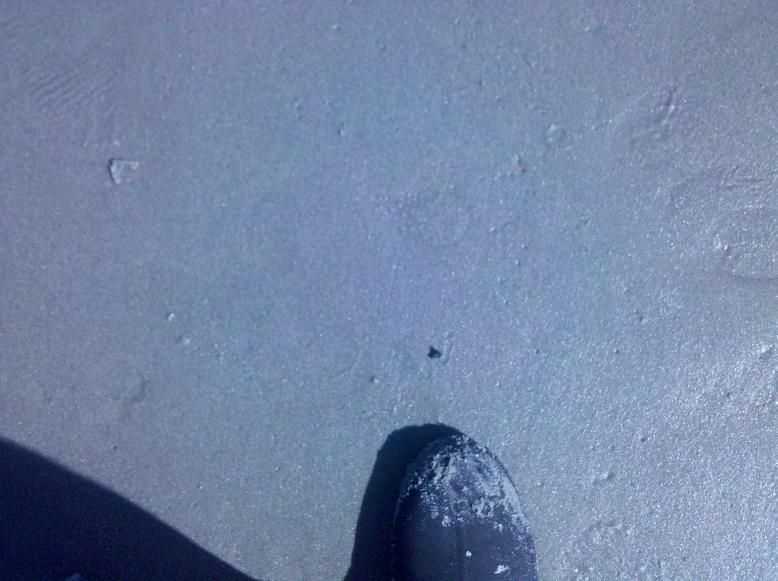 |
| Where's the tooth? When they lay on sand with nothing around them, they're pretty easy to spot. |
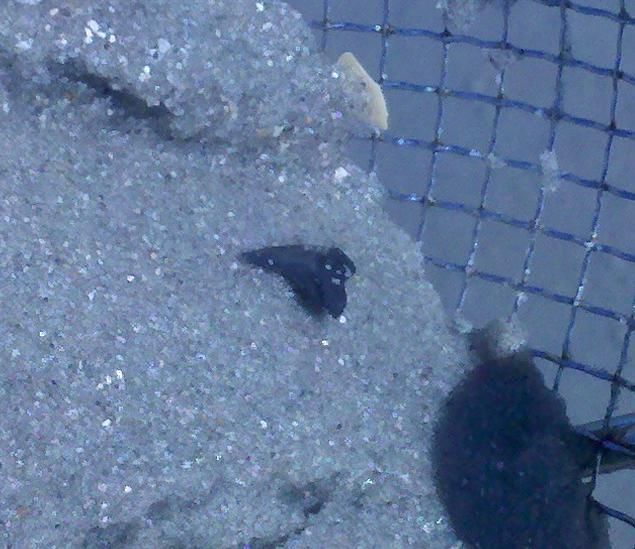 |
| This is a typical tooth. Small, maybe a bit broken, but still, a tooth. Learn to distinguish teeth from non-teeth, and you'll find the unbroken and larger teeth in the future. Get "the eye"! |
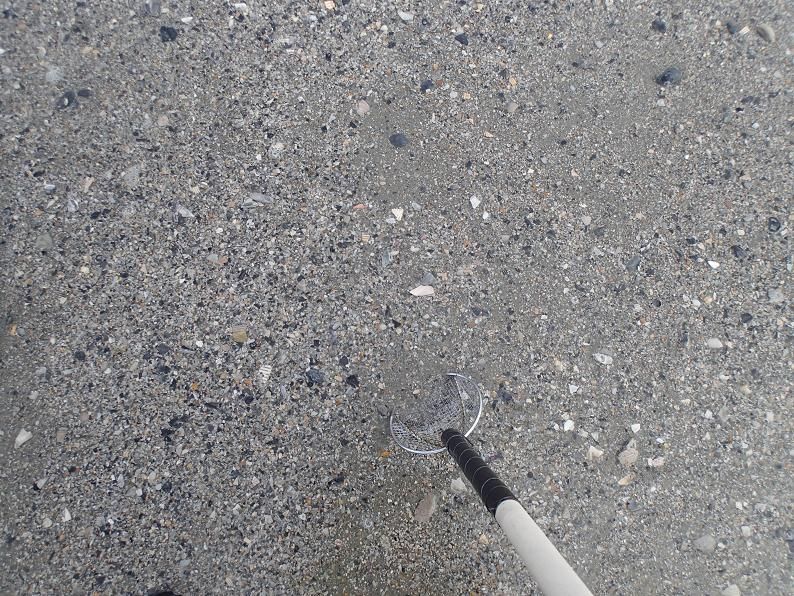 |
| Can you spot the tooth here? It's partially buried. |
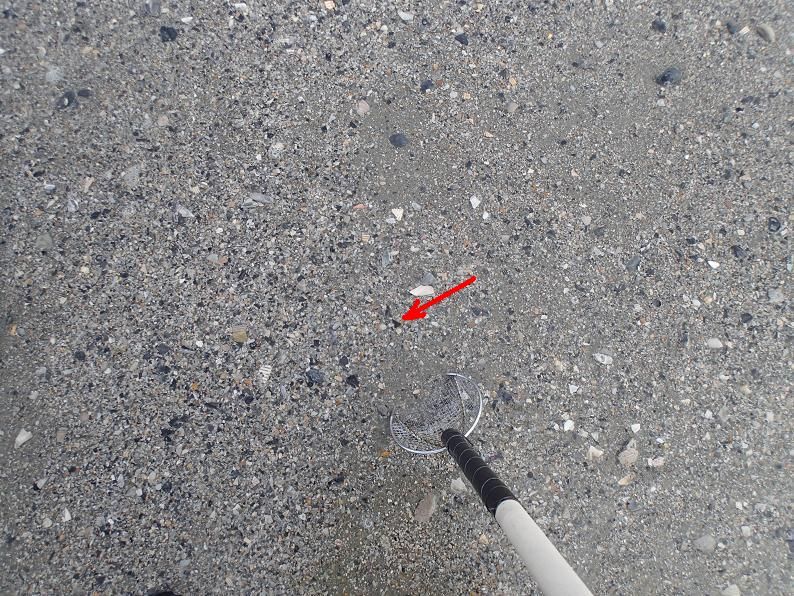 |
| Here it is! |
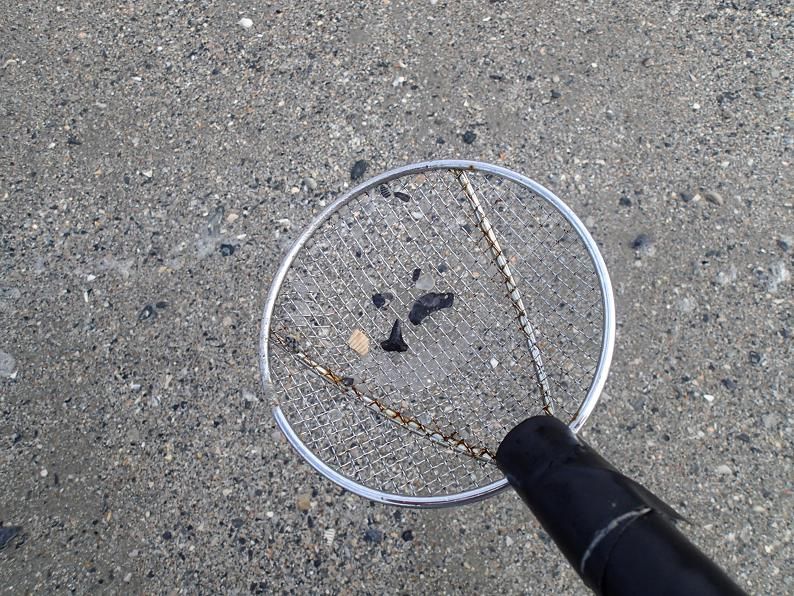 |
| Yep, it's a tooth. It looks like a bull shark or similar requiem shark lower tooth. |
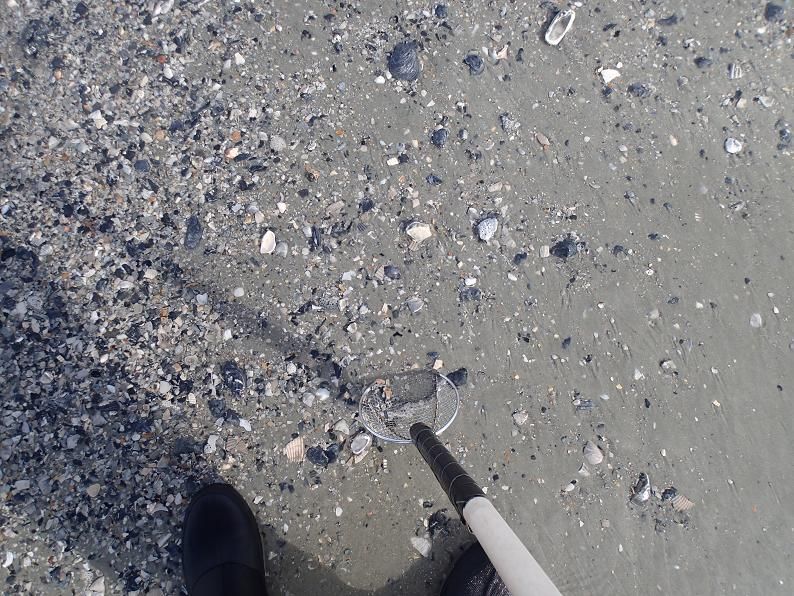 |
| This one is even harder to see. I've given you a hint though! |
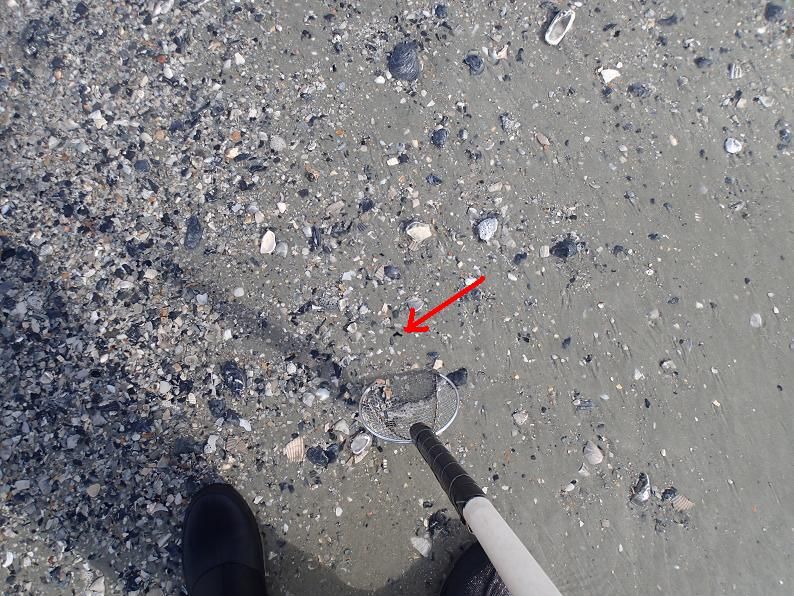 |
| Here it is! |
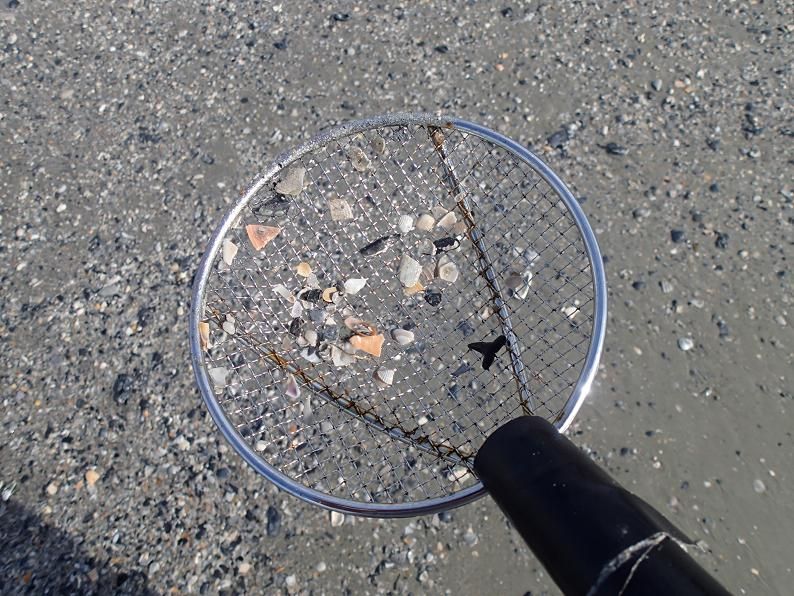 |
| It's another requiem shark lower tooth! Make sure that you check things out that are partially buried, they could be a shark tooth. |
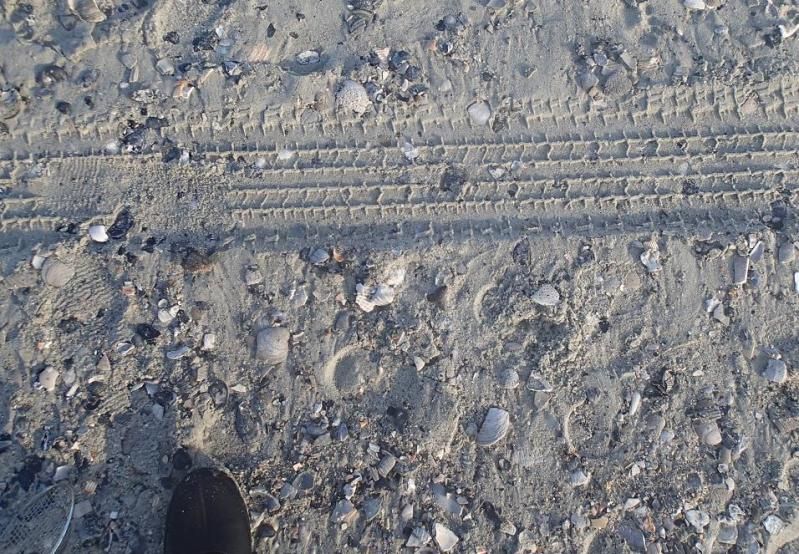 |
| There's a bigger tooth here. This, like many of the larger teeth, are higher up on the beach, perhaps because they are heavier, or perhaps because that beach material has yet to be eroded as much? Notice how close a vehicle came to pushing this tooth deep into the sand! |
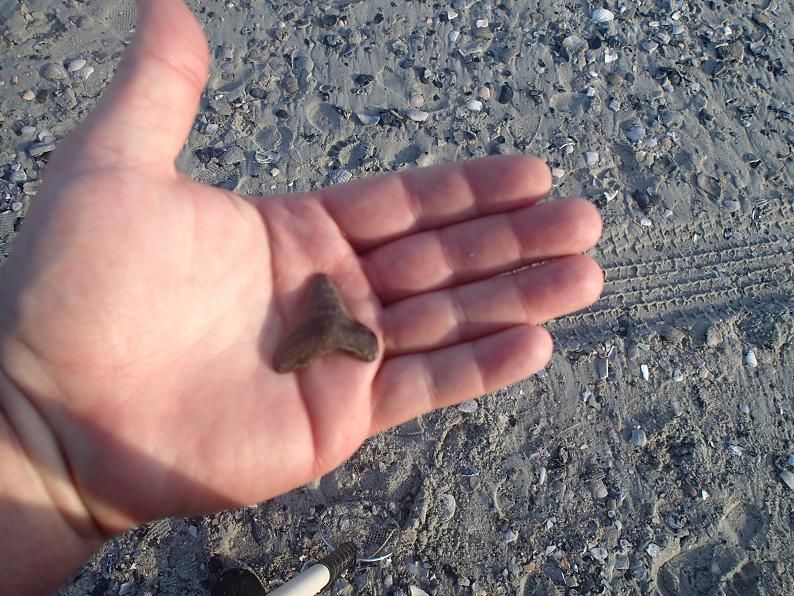 |
| It's a small worn megalodon, or a "meg", tooth! Meg teeth aren't common, but it's possible to find them at Myrtle Beach. Sometimes you'll find fragments that are difficult to recognize as teeth. |
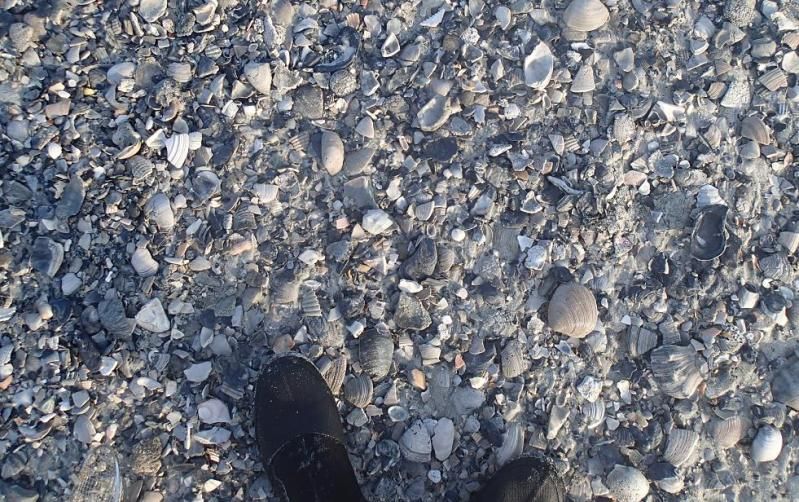 |
| There's a large tooth amongst the shells. Can you see it? |
 |
| This one is very difficult to see because it's not black as are many of the other fossils. The gray coloration blends closely with the colors of the shells. What set this one apart was the shine of the enamel and the general shape. |
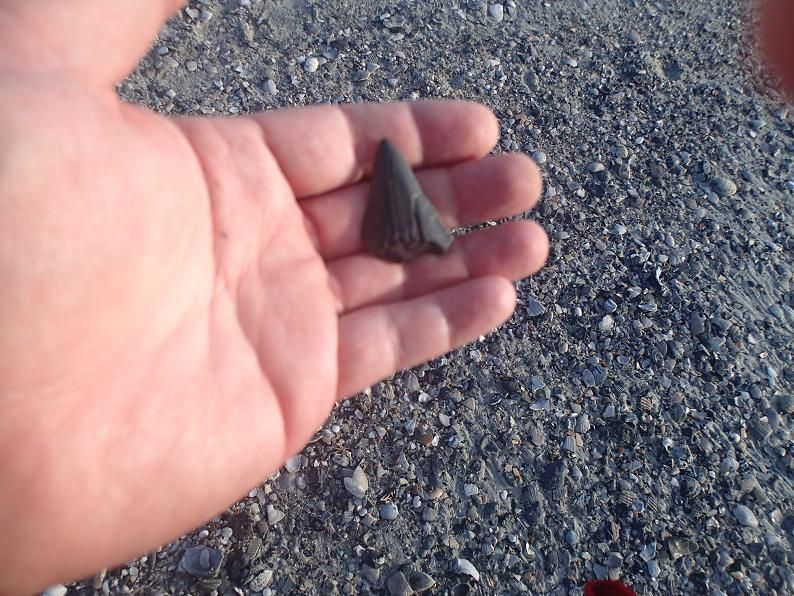 |
| It's a tooth from a great white shark. Too bad the root has been broken off. Still, this is a nice find at Myrtle Beach. |
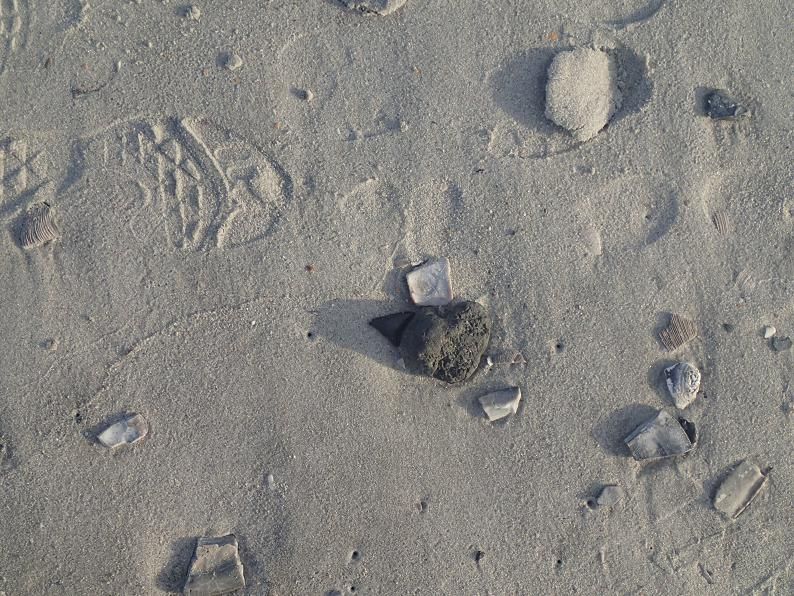 |
| Here's another tooth found high on the beach. A jogger or hiker stepped right over it! |
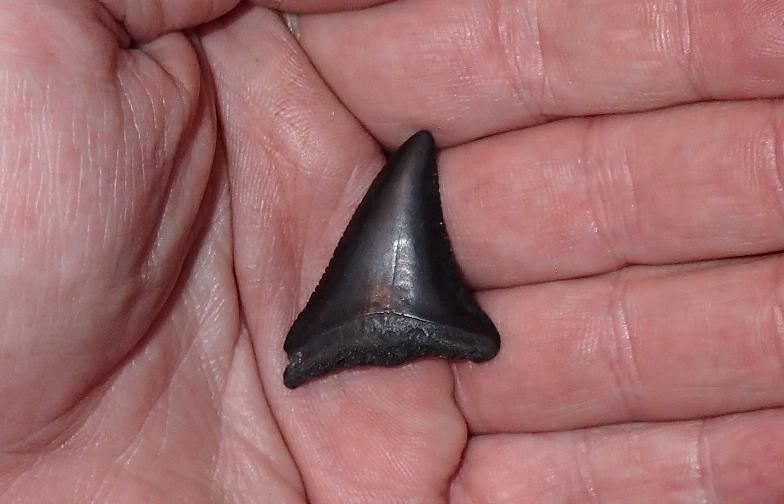 |
| Here's the tooth. This great white shark tooth is pitch black. It has a nice tip and almost all of the serrations, but the root has been partially broken off. Still, a great find! |
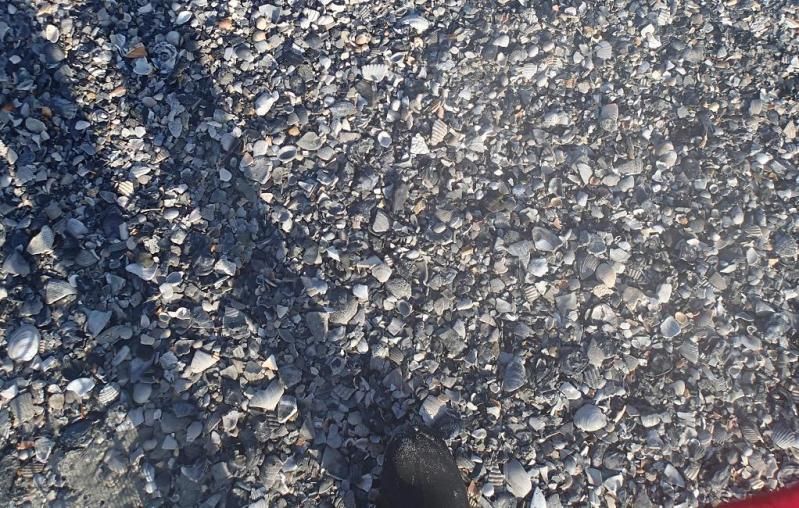 |
| There's a meg fragment amongst the shells in this picture. Can you spot it? |
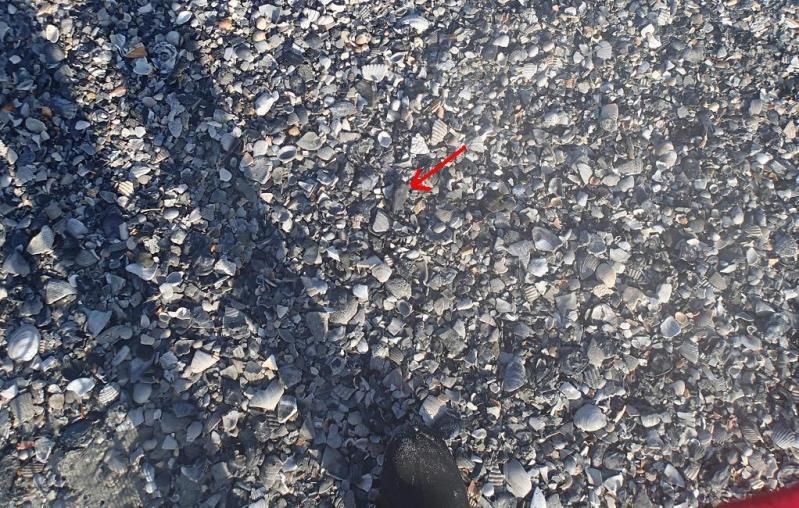 |
| The meg fragment looks like a rock. Several folks that I spoke to about this tooth mentioned that they'd toss it away not knowing that it was a shark tooth at all. |
 |
| It's only half, and missing the root, but this megalodon fragment gives me hope that some day I'll find a whole one in good shape at Myrtle Beach. It sure gives you an idea just how large these teeth can be. This shark may have been forty feet long or more. Megalodon became extinct more than two million years ago. |
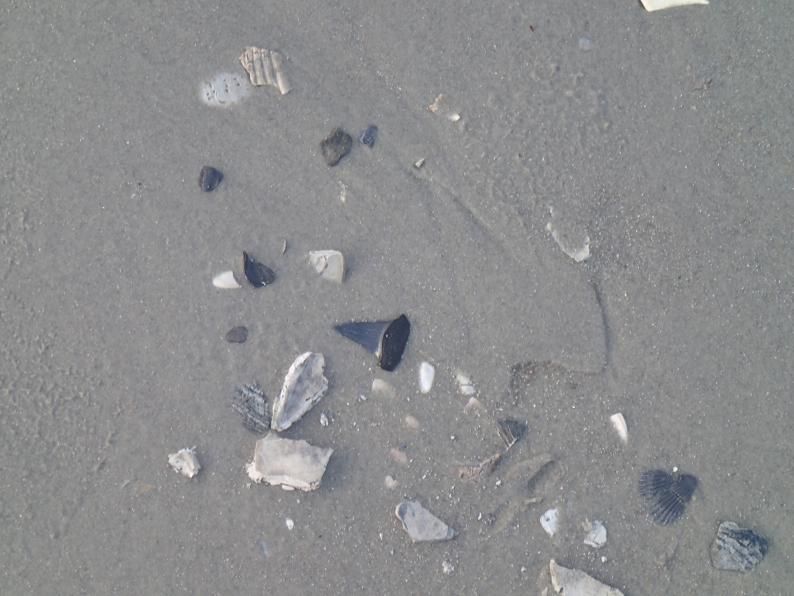 |
| I saved the best for last. Remember when I said that big teeth are found around big stuff? I guess you could say that it's true here too, but this tooth was pretty much in the open. It's my best great white tooth to date from Myrtle Beach. I was actually walking back to my hotel, not really looking for teeth but with my head habitually looking down when I spotted this tooth. I was stunned, but managed to snap a pic before jumping up and down. |
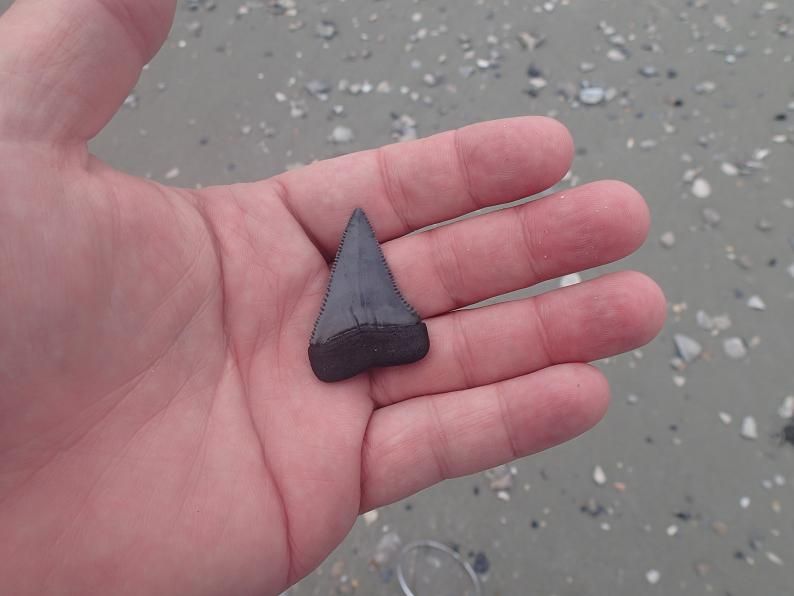 |
| Here's the labial view of that tooth. Labial view refers to the side of the tooth that faces away from the sharks mouth. If you see this as a shark approaches, you still have a chance to get away! |
 |
| This is the lingual (tongue) view of that great white tooth. If you see this side of the tooth, it's too late, you've already been consumed! This not only is one of the best great white shark teeth that I've ever found at Myrtle Beach, it's one of the best in my collection. The tip, root and all of the serrations except for one are intact. Almost perfect! But, it's perfect to me! |
You may be wondering why I pick up the small broken teeth, or the small whole teeth, as long as there are teeth like those great whites pictured above on the beach. I spoke earlier about getting "the eye", and spotting small teeth or even fragments of teeth keeps my eye sharp. Also, I tend to give away almost as many of the smaller teeth that I find to kids and/or parents on the beach, to help them find teeth. Giving them a tooth supplies them with an example of what to look for. And, I enjoy seeing the faces of kids light up when I give them a nice tooth. My daughter referred to me jokingly as the summer Santa of Myrtle Beach. All I can do is laugh at that idea.
But, when you think about it, maybe when I give teeth away, good collecting Karma will come my way. It does seem that when I give a tooth away, I find a replacement that is as good or better. So, when you become adept at finding shark teeth, keep that in mind. You'll pass on the hobby, make some friends on the beach, and bring a smile to someone's face, and in return, maybe you'll get some good toothin' karma!
Hopefully this info will help you find shark teeth at Myrtle Beach. If you've never collected them, it's a great way to spend some time with your family doing something fun on the beach. I've spent countless hours with my daughter looking for shark teeth at Myrtle Beach. She has the eagle eye for them for sure, and even though she's now an adult finding her way through her college life, I still treasure my quality time while vacationing with her at the Beach.
My next post will lay out the basic shapes and types of teeth and fossils that you'll find to help you identify what they are, so stay tuned.





































70 comments:
Hi, I am from good ole South Carolina, and I just found and read your article about hunting teeth at Myrtle Beach.
First let me say : I am giddy with excitement.....we leave for Myrtle B. in 22 more days!
I am not a beginner, my hub and I have been crazy ,avid shark teeth hunters for a number years now.
We always go to Myrtle B. every year and look so forward to doing so.
YOUR article hits the nail straight on top of the head!!!!!
I don't think you missed a thing about the whole entire subject.I would have added when looking as a beginner...that MOST of the time if you are unsure .......shells break and MOST of the time the teeth do not. agree??????
What I am trying to say is : I feel you ,man!!!!!!!!
Every aspect ,or angle is exactly the way we feel AND do to be exact!
I got so excited reading this , and thank you, share your joy and feel the same way
I laughed so hard when I read the part about snapping a photo before jumping up and down!!! I totally understand.
Our biggest find is a beautiful 2 and half inch great white tooth...wish I could send photo!
Who knows maybe in 3 weeks a MEGGIE !!!!
Thank you so much for the kind words and comment, it's very much appreciated! I hope y'all find a personal best great white tooth or meg tooth on your upcoming trip! I'm a bit jealous that you're going :) Anyway, you can find me (Fat Boy) on www.thefossilforum.com and www.blackriverfossils.org and post your pics, or send messages to me on those sites. The forums are free, and they don't spam, and are full of terrific fossiling information and both have fantastic members, many that I collect with. Thanks again!
I forgot to add, yep, I agree that the teeth are stronger than the shells, and for all but the most fragile teeth (sand tigers and sandbar sharks), that test works just fine. I used to apply that test until one time, while collecting on a river in my home state, I picked up what I thought was a fossil and did the squeeze test. It crushed between my fingers, so I thought it wasn't a fossil...that is...until I found it in a fossil collecting book! It was a beautiful Eocene drumfish tooth until I turned it into fragments!!!! So what I do now is, if I'm in doubt, I keep it and examine it at home under light and a magnifying glass. If it's a fossil, I keep it, if not, I trash it later. I can tell you that there are times when I keep something that I'm sure is a fossil and it turns out to be a modern bone or wood upon closer examination. I kept someones old chicken wing bone one time!!!!
I sell a product just like the skimmer you made. Would love to give you one in exchange for a mention of product on your website. skip@sanddipper.com
I love finding shark teeth I found 11 so far I'm in myrtle beach right know I also thought your directions were great
Thank you for the feedback, glad I could help! I'm jealous that you're out there collecting and I'm stuck at home away from the beach :) Good luck!
I'm currently in North Myrtle Beach, and I found one the other morning. Other than that, I've been searching every day and morning and nothing lol. Anymore advice?
Hang in there Samantha and keep trying. Once you find a few, you'll get the eye. They are there. My advice, get up early and if the tide is out, search the edges of the shell bed. If the tide is up, or moving out or in, search the water's edge where it meets a shell bed. Sometimes, the waves will separate a tooth from the rest to an easy to see spot (sandy spot). Be quick or have a tool to catch it before the next wave. Look for shelly areas that have old ugly grey shells and lot's of black fossilized material too. If the waves are washing that stuff around, you should find some teeth. Think small too, like 1/2", once you find them, the bigger ones will be easy to see. Until you "get the eye", focus on black stuff only...and do your best to ignore the shells (as hard as that might be). You'll find them, just don't give up! Good luck!
Oh yeah, you'll find them in bunches sometimes. If you find a spot where it gives up a tooth or two, chances are that spot will give up more. If you are searching an area that doesn't seem to have that fossil material, move a ways up or down the beach until you find that stuff and search again. There are good areas and not so good areas, not sure why, but keep going back to the good areas once you find them. Don't waste too much time if you aren't finding anything at one spot, if you gave it a good effort, move to a different section of beach and try again. Sooner or later, you'll find a good spot!
One other thing, LOL, if you see someone finding shark teeth, and they have some, chances are that area is worth looking. There is no way that one person will find all of them no matter how experienced they are at finding them. Don't be afraid if you find someone that knows how to find them to ask for help. Most people would be happy to show you the ropes!
Just wanted to say that on we just started a small trip here to Myrtle Beach , and my 7 year old was wondering if we could find shark teeth. I said "sure", just to make him happy. However, I have never done it, and didn't know you actually could. Wouldn't you know, we were walking along, and lo and behold, something catches my eye, and it's a small 1/2 inch, but whole pointy shark tooth. We got excited, and proceeded to find 12 more In a short time, and saw 2 or 3 others doing the same. So, I searched and found your thread here. Great page, and I can tell you we'll be making a few more trips this week. Very excited.
Just curious, I am wondering how to tell which kind we found. The ones with the root still attached were from 1/4 to 1/2 inches long, very thin (shorter ones teeny bit fatter), and jet black. Sharp as sharp could be. I picture them more as grabbing and holding teeth, more than tearing type tooth. They were all found rolling in the surf line
Thanks again for all the info. I now want a bigger one, so I will not pass up all those shell beds like I did today.....lol
Oh, and I forgot to mention that I have never tried to look for teeth before, not realizing the possibility existed. So I am a complete Newbie. Very cool how easy they are to find.
Thanks Vermonster for the feedback. It sounds like you found teeth from a sand tiger shark. There are several species that you can find at Myrtle Beach, so to best match up your tooth and identify it, if it's not too worn, check out www.elasmo.com. There are several different formations, and although they aren't exactly the same as those on the site, they're roughly the same time period. You'll see a link for Lee Creek on the menu, that will show you the majority of species from the Miocene and Pliocene that you may find at Myrtle Beach. You sand tiger probably was from one of those periods. It's hard to tell what formation your tooth came from because it was found on floating sand, not in the rock formation, so we can only speculate really. The older stuff, browse the site and look for Cretaceous faunas, and you may be able to ID some teeth there too. Now you're addicted too! Good luck finding more!
Just came home from Myrtle and found a small handful of teeth! I was watching other people sifting the sand and looking for something when I asked someone what they were doing. I was thrilled to find some myself. I sat my beach chair right where the waves were coming in and would take a handful of whatever was washed in and search through it. I also tried the method of digging a small hole that would catch the finer particles as they washed in. Both worked great! I can't wait to go to Myrtle again next year and see if I can find more. Your blog was very helpful! I wish I would have read it before going. You didn't miss a thing! (by the way....all the teeth I found were in the Cherry Grove area close to the pier)
Thank you for the nice compliment! Also, I'm glad that you were able to find some and discover this fun thing to do there. Now you are hooked too! My first few trips were to Cherry Grove...I remember many a walk back and forth from where we stayed to that pier. In fact, the first time that I found shark teeth, it was there. Prior to that, I had no idea that they were there. Although I've collected teeth elsewhere, my habit of looking down and the shape recognition training that I put myself through paid off, allowing me to find that first tooth. Since then, I've stayed in various places along the Grand Strand, and have found good numbers of teeth at each of them.
We have been hunting teeth in Myrtle Beach for years. Grandparents, parents and kids all enjoy the hunt.
We take our best teeth to the Gay Dolphin at the strip and Tom (I think that is his name) will wire them for you and you can proudly display them on a necklace. He also has shark tooth hunter t-shirts and hats too! Good Luck on your hunt!
Great article. I love hunting for sharks teeth and found a lot of this to be very helpful.
Your advice is right on. I have been hunting teeth for several years now and getting ready to go back the end of August. I usually get 75-100 a day. I go out in the morning and the evening. Found my largest one last year at Myrtle and it just drifted in to my left side.
Great blog! went to Myrtle last year and found some teeth and was hooked. I just got back from Myrtle Beach this week, wish I read this before I left...but still had a good week I think!?
I ran into someone on the beach using a scoop made out of a 5" strainer and golf club handle...I now own!
I am pretty sure I found over 100 Shark teeth...a few good finds. Found 3 prehistoric aligator scoots (which were under the skin and gave them their humps on their back.)
3 Great White Shark teeth, the biggest an upper 3/4", and a lower about 3/4", and a tip from a broken tooth.
And a barb from a Stingray. The rest are just a variety (small and long teeth) of sharks ...??...
Thank you Pete and Jim! I can't wait to get back there myself.
Jim, I saw your post on The Fossil Forum, very cool stuff. I've never found croc scutes or teeth from Myrtle Beach, so those are some very cool finds. Maybe I'll luck into some next time, so you can bet I'll have my eye out for them next time. You just never know what will show up.
Also, thank you everyone for visiting this page and for those that left comments, thank you so much. Hopefully, I'll have more to share some day soon. It's been a while since I've been collecting. I've been fishing too much I guess!
I love your article. It was fun to read. Also very informative. I've been into it about 1 1/2 years now. I love looking for them. Next time I go looking for teeth, I will be thinking of you. Thanks, Barbie
Thanks for the feedback Barbie. I hope it helps you out next time. Next on my list is to post a fossil ID page for what you can find on the beach (from the viewpoint of an amateur collector). I'm working on it now, but it's a lot of work (going through my collection, taking photos and such). Hopefully, I'll have it out very soon.
Heading to the Outer Banks in a few days. Hope they have a good deal of teeth also. Good writeup and like your sifting tool. Think I found a new retirement gig, even though I can't retire for 8 more years... off to make a sifter myself! Greg
Hi, my name is kwynn, I went to myrtle beach last year and in two days I found 23 shark teeth! I only have little black ones and am going to myrtle beach this year for 3 days in 20 days from now. I wanted to know if you were giving any away for free??? I wanted to have a large one and wanted to ask you for one. If that's alright privately message me please. -kwynn
You are the genuine article, like your shark teeth! This is great. I especially relate to the aspect of giving away some... that is how I found my first teeth... a stranger on the beach gave me one. I had a picture of what they look like, but for some reason the actual tooth made it much easier to spot them in the rubble.
What a nice way to honor your brother.
Im enjoying my vaca with my family on our first trip to myrtle beach. I found a great white tooth that looks just like the one you pictured and it is in perfect shape! I used your picture to identify it. Your info was really helpful. Thank you!
Greg, hope you can get that retirement gig worked out. I'm leaning toward that someday myself.
Kwynn, that's great! Now that you have the eye, your next three days there should be productive. Keep a close eye out and you'll find some bigger ones!
Thanks Anonymous, an actual tooth does make it easier.
Brian, that is awesome that you found a nice great white tooth, congratulations! Glad that I could help you ID it!
Here in Myrtle Beach now my daughter, grandson and I have found over a hundred sharks teeth in the past couple weeks but today my daughter found a perfect great white she was so happy. That is one of the most relaxing hobbies a person can have. Thank you for your post it was very helpful
You're quite welcome Rebekah. Wow, that is a fantastic find for your daughter! Yes, it's a very relaxing and a great way to spend time with your family. Finding lots of cool stuff is a bonus. Last year was the first year that we didn't make it down in a long time. I hope to remedy that soon :) Good luck with the future collecting!
Hi, just came in from N. Myrtle. Went from Main St. all the way down to the end of Cherry Grove. Didn't find a single tooth. Found no true shell beds, just a lot of broken sand dollars. Did the hurricane in Oct. have a negative impact and are the beaches better in S. Myrtle? Will be headed back out on Friday.
Thanks!!
OOPPSS! That was from 9th Ave...not Main St!
Will be searching around Hog Inlet Friday
I have lived in Myrtle Beach since October. I just started hunting shark teeth last month. As of today i have found 137 shark teeth. Big and small. I am addicted to this adventure. It is so amazing what you can find. I do everything you have mentioned. Lol i have a lot of people asking me what I'm doing. Once i tell them and show them they are so overwhelmed at hiw many i have found. Tbanks for this article. It is very on point for beginners.
That's fantastic! Welcome to the addiction!!! Part of the fun is sharing what you're doing with people.
To the poster that left the comment above about having trouble finding them, that went to Hog Inlet, I'm curious how you did. If you didn't have any luck, keep at it. Once you find a few and "get the eye", you'll start finding a bunch of them. Good luck!
Hello!! Loved reading your post! Two years ago in Topsail, I found 70-odd, mostly smaller, black, shark teeth. Right now, I'm posting this from Kitty Hawk. Went out to the beach today, and found very few black shark teeth (2-5), but a TON of "shell colored" teeth (or so I thought). They seem so distinctively tooth-shaped (and I feel like I have a decent eye). But now that I'm home, I'm wondering whether these are all just tooth-shaped broken shell pieces. :( Many have shell "stripes" on them, but I swear they are that recognizeable tooth shape, so distinct!! Am I deluding myself?? If you think they could be teeth, what stage of fossilization/mineralization would this be?
Thanks for your informative and helpful Web page. Very useful/insightful Intel.
Anyway, I found this beautiful - almost perfect - fossilized Great White tooth in the heart of Myrtle Beach. Surprisingly, it was in a high traffic area.
I walked down to the beach a few minutes after high tide as the sun was setting. I found a few small Tiger Shark Teeth, but as I was giving up and going in, I found this beauty. It was in a recently uncovered shell bank (as the tide was going out).
Needless to say, I was ecstatic. It's my best tooth yet in the year I have been looking.
https://goo.gl/photos/6qXXkViJgshdUTUE8
Hi Erin.
It sounds like you've got a pretty good eye and have found some of these before. That fact that you found some at Kitty Hawk is pretty good, because they're not as common there from what I understand. As far as the lighter colored stuff that you found at Kitty Hawk, it's tough for me to say because I'd need to see a picture. The colors of fossilized shark teeth are due to various minerals from the sediment that they're buried in that leach into the teeth during the length of time that they're buried as the teeth fossilize over millions of years. Fossilized teeth can show up as a variety of colors, depending on the types of minerals that cause the coloration. As far as whether or not you have a tooth or not, almost all shark teeth have a well defined sharp blade, even sand tiger sharks, and are even. There are no square edges on whole teeth along the blade. That is one way to distinguish something that might be shaped like a tooth (like a broken piece of a sea shell) and an actual tooth.
Mike, that's a beautiful great white shark tooth, congratulations! It's amazing that you can find such wonderful teeth sometimes in the middle of a crowded beach, with lots of people looking for them and for seashells! I'm glad that you liked the blog post and that it was helpful to you. :)
Hi Mike! Thanks so much for the info!!
I posted a couple links to the pics. These are about half of what I found. I didn't put any of the "normal black" shark teeth in this pic, because I was certain about those!
The stripes in these pictured are majorly throwing me off. What do you think? Teeth or shells? :D
https://goo.gl/photos/GVrop2GHoER3bC4a9
https://goo.gl/photos/tGgT1vzW2Tfmq1gY7
https://goo.gl/photos/njiyw4TQSHaUhrjf6
Sorry! Not Mike!! I was looking at the previous poster!!
No problem Erin, I've been called much worse! :)
I'm sorry to disappoint you, but I think that what you have are worn shell fragments that resemble shark teeth. They're probably the "wings" of a scallop or similar bivalve that have broken off the main shell along with a section of the hinge, then worn in the surf. The striations that you see might be either from the natural color of the shell, or perhaps even worn ribs of the scallop. Do a search on "scallop shell anatomy" and check out the wings.
Another possibility is that could be the fragment of a whelk siphon canal area of the shell, but in my opinion, that area of the shell isn't flat enough to wear down to resemble a tooth like a scallop wing would.
The link below shows a picture of several angles of a fossilized tooth of a sand tiger shark Carcharias taurus, common to the Myrtle Beach formations and probably the sand tiger teeth that we find there, that resembles what you've found in shape, sort of.
http://elasmo.com/genera/pics/neogene/ds1048h-web.jpg
You can see clearly in the second image from the left that the blade has a clear cutting edge, and the root is well defined (kind of dull) while the blade has definite enamel on it. In all of the pictures, you can see a clear delineation of the blade and the root. Even on teeth that are extremely worn by wave activity, you can still make out these features.
However, your collection in the pictures is very interesting in itself, worthy of its own display. The colors and shapes really are quite pretty.
It's clear that you've developed and eye to pick up similar shapes at Kitty Hawk to those of shark teeth. I think that if you make it back to Myrtle Beach or those South of Cape Fear, you should have no trouble finding a bunch of teeth with your keen eyes.
Good luck collecting!
-Kevin
By the way, Erin, and others, elasmo.com is an outstanding website to identify your shark teeth fossils. The fauna found at Myrtle Beach are similar to those on this site (although the formations could be different but from similar time periods). For example, the teeth in Peedee, Castle Hayne, Belgrade, Black Creek, and Lee Creek faunas on Elasmo.com would be very similar to those found at Myrtle Beach, if not even the same.
Oh, and also Erin and Mike, thank you so much for your comments and feedback. I really appreciate it!
Hi Kevin!
Thanks so much for taking the time to respond so thoroughly! I was leaning toward the same conclusion with those stripes. I thought it was odd I found so many that shape, but there must be certain shells that commonly break that way for whatever reason. They are very pretty, though! Maybe I'll make some jewelry out of them :).
Next time we're on the east coast, I'll definitely use elasmo.com.
Happy teeth-hunting!
Thanks!
Erin
Thank you Erin! If you make jewelry out of them, please share a picture here of your work! They are beautiful and unique. I hope to get down to Myrtle Beach again later this summer for some collecting. I'll blog about the experience afterward.
Hey Mike,
Today I found a tooth, jet black, about an inch in size. It was my first tooth ever! Any idea as to what it could be?
Love looking for them every year down there. Found over 400 in a week back in June, heading back in Sept. Can't wait. Happy hunting!
@Shane
To Anonymous. That's a nice sized tooth. Congrats on your first tooth! I'd have to see a picture to identify it. -Kevin
Shane, that's a great week of collecting! I'm making plans to get down there again. I can't wait either!!!
I found my first almost thirty years ago in the Outer Banks (none since). I've been going to Myrtle for the last five years. I watch while she'll collecting and finally found a small one this trip on this past Tuesday. I went out on Wednesday morning and found three more small ones and a medium broken one. That evening, about 3/4" skinny one. My husband has complained that the first ones were too small. He seemed pretty happy with the larger one. So Thursday, our anniversary, I found another about 3/4" tooth! It was nice and arrowhead shaped, but it had a notch broken off the root. He was really happy with that one. I plan on wiring it and hanging it from a leather cord for him. I did a search on the colors and found you. I love your tutorial! We just got home in Virginia. I can't wait til next year!
Hi Shelby. Thank you so much! I'm glad that you found some teeth. Congratulations! Now you have the shark tooth hunting addiction too! Once you get "the eye", it's always that feeling that you can't wait to get back. We went to MB recently too and did fairly well collecting. Most of the teeth are small or broken, but now and then you find a really nice tooth or some other fossil. I think that what I like best is that I have a chance to find some species that I can't find at my closer to home spots, and the variety of what you can find. Let me know how you do the next time!
Found your blog. Its really nice on megalodon fossil teeth.I appreciate your article. Its important to get quality information on megalodon fossils teeth. So thanks for sharing all that important information.
Oh Wow! I know exactly where your picture of the “creek mouth” was taken. We actually have a timeshare there and i have spent many, many hours in that exact spot! What a small world!
No
BIg Shark Fish
This was great. I have 2 more days left here in North Myrtle and have always wanted to find one. Wish me luck!
FINALLY found one! Thanks again!
Thank you Invest Fossils.
Thank you Angie! Yes, it's a small world. Nothing secret about that spot, right? It's something fun to do at the beach. Maybe I'll see you there sometime!
Thanks Unknown, glad that you found a tooth. Now, you've started a collection and are ready to find more, right?
Thank you for sharing. I shared your pics with my elementary class to show them where to look! You have encouraged me since you found large teeth. I figured you could only find small ones st Myrtle Beach! I don’t know about the millions of years though. It doesn’t take that long...just the right conditions for fossilization! Thanks for the article!
Thank you Anonymous! You will find small ones, but keep at it, there are some nice ones there!
I appreciate the detailed write-up. Very well done. I'm headed to Myrtle Beach the end of June and I'm hoping to do some shark teeth hunting. Cheers.
Thank you. Good luck on your trip! Let me know how you do!
Fellow hunter here. FatBoy and I share the same technique in our search. You really just need to train your eyes to what the tooth looks like. The black in the teeth in my opinion makes them stand out against the broken and black shells. It has a gloss like finish when the sun hits it. When it’s wet it a little harder. But that when the shape of it factors in. Happy hunting!
Shark tooth hunting was about all I wanted to do when I visited Myrtle Beach as a kid. I was good at it and found several hundred, but one was like the OP's big black Great White tooth. Our family usually stayed south of the Family Kingdom and the hunting was good there. Sometimes, we would walk way up past the Gay Dolphin, and there were no teeth on the beach there. This was back in the early 70's. At the Gay Dolphin, they had a tooth for sale forever for $35 ($230 today). It was huge and thick, and whatever it was, it was not a Great White tooth. As I grew up, I got interested in other things. After going to college, after exams, is when I discovered North Myrtle Beach and all the great party places. But I would always walk the beach, looking for teeth. I never found any. But I always knew if I went down to my old stomping grounds, I would find some, and I did. I had no idea why. Somewhere thru the years, I learned about the Megalodon, and I realized that's what the Gay Dolphin was selling for $35. During the Meg's time, and every other type of shark, including ancient Great Whites, the eastern seaboard was under water. The Megs and all the other species did their thing, and in doing so dropped their teeth, which are replaced in their jaws like a little conveyor belt. The teeth fell to the ocean floor and got covered in sediment. Over the eons, those teeth became fossilized. And eventually, sea levels dropped and those seabeds became dry land. As creeks and rivers formed, they cut through the old seabed, exposing the teeth and carried them towards the ocean. Today, most Meg teeth are found by divers in rivers in NC, SC, GA and FL, even up to Maryland. There are a few famous dry land deposits (Lee Creek and Aurora, NC for example). And upon learning this, I remembered there was a stream that flowed onto and across the beach north of where we used to stay. That stream actually flows through the Family Kingdom Amusement Park. At Myrtle beach, and all the way up the coast for miles, the tides tend to flow to the south, and this is why I always found sharks' teeth around the Captain's Quarters Motel. And I would bet that you will find them on those beaches anywhere a stream to the north flows across the beach and into the ocean.
Very cool history and info, thanks for sharing. So far, I've found teeth at every beach that I tried, except at the State Park. For some reason, there weren't any teeth there when we visited, just a lot of sand and very few shelly material. Beaches change over time, so I'm sure that since then, there may have been times when they were plentyful. To be fair, we didn't have much time to collect that day, and didn't wander very far, so there may have been some further up or down the beach from where we hung out that day.
Started going down Myrtle for 3 vacations a year last year. Found about 2800 those 3 weeks last year. Heading down end of March, getting close, can't wait!
That's awesome Sharktooth hunter! I'm jealous. How did you do?
Hi Tina.
I will email you. But, one of the best resources for identifying your teeth and many other fossils is elasmo.com. Just click on the word "Faunas" at the top of the page and a list of links to various locations will appear. For Myrtle Beach, most of the teeth can be found on the Lee Creek one. MB has some cretaceous fossils, which can be identified on the Black Creek page. You may also encounter some that you may see on the Castle Hayne page. I hope that this helps!
Sorry that it took so long to get back to you.
My 9 year old son found his first small black shark tooth with the root attached and he was so excited! I stumbled upon this blog while googling to learn more and it was very helpful! I love your “find the shark tooth” photos and how you give the answer. Thanks!
Dear Anonymous. I'm so happy that your son found that tooth. I hope he's hooked now because this is a great hobby that will entertain him and you for years. I'm glad that my blog post helped you. Here's to finding more teeth!
Hello friend, very amazing blog you have compiled here. Have a question for you though, seems like the shell beds are becoming harder and harder to find with each passing year. Have storms changed the geography of the beaches that much? We stay south of Myrtle in Garden City, and there used to be amazing hunting down here over the last decade but it seems like that is drying up. Just wanted to pick your brain to see if you know of any reasoning behind it. Thank you and good hunting!
-Mark
Post a Comment